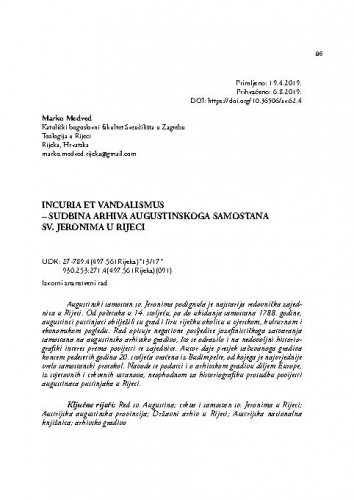Augustinski samostan sv. Jeronima podignula je najstarija redovnička zajednica u Rijeci. Od početaka u 14. stoljeću, pa do ukidanja samostana 1788. godine, augustinci pustinjaci obilježili su grad i širu riječku okolicu u vjerskom, kulturnom i ekonomskom pogledu. Rad opisuje negativne posljedice jozefinističkoga zatvaranja samostana na augustinsko arhivsko gradivo, što se odrazilo i na nedovoljni historiografski interes prema povijesti te zajednice. Autor daje presjek sačuvanoga gradiva koncem pedesetih godina 20. stoljeća vraćena iz Budimpešte, od kojega je najvrjednije vrelo samostanski protokol. Navode se podatci i o arhivskom gradivu diljem Europe, iz svjetovnih i crkvenih ustanova, neophodnom za historiografsku prosudbu povijesti augustinaca pustinjaka u Rijeci.; The history of the Order of Saint Augustine in Rijeka links the city and its region with Central Europe – more particularly to Bavaria, Bohemia, Austria, Slovenia and Italy. Unfortunately, the past of the Augustinian convent of St. Jerome is mostly unknown. The Order of St. Augustine was in fact the first religious community in Rijeka. The monastery, founded by the noble families of Devin and Walsee, existed from the 14th century till 1788, when it was dissolved by Joseph II. The archive suffered two main disasters: in 1509, when the Venetians partially destroyed it, and in 1788, the year of its closure. The Augustinian archive remained partially in the State Archives in Rijeka, but the largest part of its precious holdings was displaced. However, part of the archive disappeared. Cimiotti-Steimberg, a historian from Rijeka, speaks of that fact as incuria et vandalismus (negligence and vandalism). Part of the convent’s archive returned to Croatia during the 19th century, but the Hungarian politics of centralization, led by Khuen-Héderváry, displaced again the Augustinian documents to Budapest. Finally, the 1958 restitution replaced the holdings back to Croatia. We can only partially assess the content of the archival holdings because many sources mention inventories, registries and urbaria that the convent in Rijeka once possessed. After its dissolution, the documents of a number of Augustinian fraternities disappeared. The most important of them was the Fraternity of Immaculate Conception, that convened in the Augustinian chapel and whose members were some of the most important citizens from Rijeka. The most important contribution to the archive of the Augustinian convent took place in 1958, when the Augustinian books and documents were restituted from Budapest. They have been kept in the State Archives in Rijeka ever since.
Sažetak

 Arhivski vjesnik : 62(2019) / glavna i odgovorna urednica, editor-in-chief Rajka Bućin.
Arhivski vjesnik : 62(2019) / glavna i odgovorna urednica, editor-in-chief Rajka Bućin.